Size Distribution, Surface Coverage, Water, Carbon, and Metal Storage of Thermokarst Lakes in the Permafrost Zone of the Western Siberia Lowland
Abstract
:1. Introduction
2. Materials and Methods
2.1. Study Area
2.2. Remote Sensing Analysis
2.3. Lake Depth and Hydrochemistry
3. Results
4. Discussion
4.1. Thermokarst Lake Area and Land Surface Coverage
4.2. Stock of DOC and Metals in Thermokarst Lakes of the WSL
5. Conclusions
Acknowledgments
Author Contributions
Conflicts of Interest
References
- Lehner, B.; Doll, P. Development and validation of a global database of lakes, reservoirs and wetlands. J. Hydrol. 2004, 296, 1–22. [Google Scholar] [CrossRef]
- Downing, J.A.; Prairie, Y.T. The global abundance and size distribution of lakes, ponds, and impoundments. Limnol. Oceanogr. 2006, 51, 2388–2397. [Google Scholar] [CrossRef]
- Verpoorter, C.; Kutser, T.; Seekel, D.A.; Tranvik, L.J. A global inventory of lakes based on high resolution satellite imagery. Geophys. Res. Lett. 2014, 41, 1–7. [Google Scholar] [CrossRef]
- Verpoorter, C.; Kutser, T.; Tranvik, L.J. Automated mapping of water bodies using Landsat multispectral data. Limnol. Oceanogr. Meth. 2012, 10, 1037–1050. [Google Scholar] [CrossRef]
- Seekell, D.A.; Carpenter, S.R.; Pace, M.L. Conditional heteroscedasticity as a leading indicator of ecological regime shifts. Am. Nat. 2011, 178, 442–451. [Google Scholar] [CrossRef] [PubMed]
- Schindler, D.W.; Bayley, S.E.; Parker, B.R.; Beaty, K.G.; Cruikshank, D.R.; Schindler, E.U.; Stainton, M.P. The effects of climatic warming on the properties of boreal lakes and streams at the Experimental Lakes Area, northwestern Ontario. Limnol. Oceanogr. 1996, 41, 1004–1017. [Google Scholar] [CrossRef]
- Jankowski, T.; Livingstone, D.M.; Buhler, H.; Forster, R.; Niederhauser, P. Consequences of the 2003 European heat wave for lake temperature profiles, thermal stability, and hypolimnetic oxygen depletion: Implications for a warmer world. Limnol. Oceanogr. 2006, 51, 815–819. [Google Scholar] [CrossRef]
- Graham, M.D.; Vinebrooke, R.D. Extreme weather events alter planktonic communities in boreal lakes. Limnol. Oceanogr. 2009, 54, 2481–2492. [Google Scholar] [CrossRef]
- Tank, S.E.; Lesack, L.F.W.; Hesslein, R.H. Northern delta lakes as summertime CO2 absorbers within the Arctic landscape. Ecosystems 2009, 12, 144–157. [Google Scholar] [CrossRef]
- Tank, S.E.; Lesack, L.F.W.; Gareis, J.A.L.; Osburn, C.L.; Hesslein, R.H. Multiple tracers demonstrate distinct sources of dissolved organic matter to lakes of the Mackenzie Delta, western Canadian Arctic. Limnol. Oceanogr. 2011, 56, 1297–1309. [Google Scholar] [CrossRef]
- Bring, A.; Fedorova, I.; Dibike, Y.; Hinzman, L.; Mård, J.; Mernild, S.H.; Prowse, T.; Semenova, O.; Stuefer, S.L.; Woo, M.-K. Arctic terrestrial hydrology: A synthesis of processes, regional effects, and research challenges. J. Geophys. Res. Biogeosci. 2016, 121, 621–649. [Google Scholar] [CrossRef]
- Frey, K.E.; Siegel, D.I.; Smith, L.C. Geochemistry of west Siberian streams and their potential response to permafrost degradation. Water Resour. Res. 2007, 43, W03406. [Google Scholar] [CrossRef]
- Roach, J.; Griffith, B.; Verbyla, D.; Jones, J. Mechanisms influencing changes in lake area in Alaskan boreal forest. Glob. Chang. Biol. 2011, 17, 2567–2583. [Google Scholar] [CrossRef]
- Kirpotin, S.; Polishchuk, Y.; Bryksina, N.; Sugaipova, A.; Kouraev, A.; Zakharova, E.; Pokrovsky, O.S.; Shirokova, L.; Kolmakova, M.; Manassypov, R.; et al. West Siberian palsa peatlands: Distribution, typology, cyclic development, present day climate-driven changes, seasonal hydrology and impact on CO2 cycle. Int. J. Environ. Stud. 2011, 68, 603–623. [Google Scholar] [CrossRef]
- Zakharova, E.A.; Kouraev, A.V.; Rémy, F.; Zemtsov, V.A.; Kirpotin, S.N. Seasonal variability of the Western Siberia wetlands from satellite radar altimetry. J. Hydrol. 2014, 512, 366–378. [Google Scholar] [CrossRef]
- Marsh, P.; Russell, M.; Pohl, S.; Haywood, H.; Onclin, C. Changes in thaw lake drainage in the Western Canadian Arctic from 1950 to 2000. Hydrol. Process. 2009, 23, 145–158. [Google Scholar] [CrossRef]
- MacDonald, L.A.; Turner, K.W.; Balasubramaniam, A.M.; Wolfe, B.B.; Hall, R.I.; Sweetman, J.N. Tracking hydrological responses of a thermokarst lake in the Old Crow Flats (Yukon Territory, Canada) to recent climate variability using aerial photographs and paleolimnological methods. Hydrol. Process. 2012, 26, 117–129. [Google Scholar] [CrossRef]
- Polishchuk, Y.; Kirpotin, S.; Bryksina, N. Remote study of thermokarst lakes dynamics in West-Siberian permafrost. In Permafrost: Distribution, Composition and Impacts on Infrastructure and Ecosystems; Pokrovsky, O.S., Ed.; Nova Science Publishers: Hauppauge, NY, USA, 2014; pp. 173–204. [Google Scholar]
- Coleman, K.A.; Palmer, M.J.; Korosi, J.B.; Kokelj, S.V.; Jackson, K.; Hargan, K.E.; Mustaphi, C.J.C.; Thienpont, J.R.; Kimpe, L.E.; Blais, J.M.; et al. Tracking the impacts of recent warming and thaw of permafrost peatlands on aquatic ecosystems: A multi-proxy approach using remote sensing and lake sediments. Boreal Environ. Res. 2015, 20, 363–377. [Google Scholar]
- Boike, J.; Grau, T.; Heim, B.; Günther, F.; Langer, M.; Muster, S.; Gouttevin, I.; Lange, S. Satellite-derived changes in the permafrost landscapes of Central Yakutia, 2000–2011: Wetting, drying, and fires. Glob. Planet. Chang. 2016, 139, 116–127. [Google Scholar] [CrossRef] [Green Version]
- Tranvik, L.J.; Downing, J.A.; Cotner, J.B.; Loiselle, S.A.; Striegl, R.G.; Ballatore, T.J.; Dillon, P.; Finlay, K.; Fortino, K.; Knoll, L.B.; et al. Lakes and reservoirs as regulators of carbon cycling and climate. Limnol. Oceanogr. 2009, 54, 2298–2314. [Google Scholar] [CrossRef]
- Catalán, N.; Marcé, R.; Kothawala, D.N.; Tranvik, L.J. Organic carbon decomposition rates controlled by water retention time across inland waters. Nat. Geosci. 2016, 9, 501–504. [Google Scholar] [CrossRef]
- Walter, K.M.; Smith, L.C.; Chapin, F.S. Methane bubbling from northern lakes: Present and future contributions to the global methane budget. Philos. Trans. R. Soc. A 2007, 365, 1657–1676. [Google Scholar] [CrossRef] [PubMed]
- Laurion, I.; Vincent, W.F.; MacIntyre, S.; Retamal, L.; Dupont, C.; Francus, P.; Pienitz, R. Variability in greenhouse gas emissions from permafrost thaw ponds. Limnol. Oceanogr. 2010, 55, 115–133. [Google Scholar] [CrossRef]
- Walter Anthony, K.M.; Anthony, P. Constraining spatial variability of methane ebullition in thermokarst lakes using point-process models. J. Geophys. Res. 2013, 118, 1015–1034. [Google Scholar] [CrossRef]
- Walter Anthony, K.M.; Zimov, S.A.; Grosse, G.; Jones, M.C.; Anthony, P.M.; Chapin, F.S., III; Finlay, J.C.; Mack, M.C.; Davydov, S.; Frenzel, P.; et al. A shift of thermokarst lakes from carbon sources to sinks during the Holocene epoch. Nature 2014, 511, 452–456. [Google Scholar] [CrossRef] [PubMed]
- Zuidhoff, F.S.; Kolstrup, E. Changes in palsa distribution in relation to climate change in Laivadalen, Northern Sweden, especially 1960–1997. Permafr. Periglac. 2000, 11, 55–69. [Google Scholar] [CrossRef]
- Luoto, M.; Seppala, M. Thermokarst ponds as indicator of the former distribution of palsas in Finnish Lapland. Permafr. Periglac. 2003, 14, 19–27. [Google Scholar] [CrossRef]
- Riordan, B.; Verbyla, D.; McGuire, A.D. Shrinking ponds in subarctic Alaska based on 1950–2002 remotely sensed images. J. Geophys. Res. Biogeosci. 2006, 111, G04002. [Google Scholar] [CrossRef]
- Grosse, G.; Romanovsky, V.; Walter, K.; Morgenstern, A.; Lantuit, H.; Zimov, S. Distribution of Thermokarst Lakes and Ponds at Three Yedoma Sites in Siberia. In Proceedings of the 9th Intern Conference on Permafrost, Fairbanks, Alaska, 29 June–3 July 2008; pp. 551–556.
- Kirpotin, S.; Polishchuk, Y.; Bryksina, N. Abrupt changes of thermokarst lakes in Western Siberia: Impacts of climatic warming on permafrost melting. Int. J. Environ. Stud. 2009, 66, 423–431. [Google Scholar] [CrossRef]
- Plug, L.J.; Walls, C.; Scott, B.M. Tundra lake changes from 1978 to 2001 on the Tuktoyaktuk Peninsula, western Canadian Arctic. Geophys. Res. Lett. 2008, 35, L03502. [Google Scholar] [CrossRef]
- Jepsen, S.M.; Voss, C.I.; Walvoord, M.A.; Minsley, B.J.; Rover, J. Linkages between lake shrinkage/expansion and sublacustrine permafrost distribution determined from remote sensing of interior Alaska, USA. Geophys. Res. Lett. 2013, 40, 882–887. [Google Scholar] [CrossRef]
- Jones, B.M.; Grosse, G.; Arp, C.D.; Jones, M.C.; Walter Anthony, K.M.; Romanovsky, V.E. Modern thermokarst lake dynamics in the continuous permafrost zone, northern Seward Peninsula, Alaska. J. Geophys. Res. 2011, 116, G00M03. [Google Scholar] [CrossRef]
- Sannel, A.B.K.; Kuhry, P. Warming-induced destabilization of peat plateau/thermokarst lake complexes. J. Geophys. Res. 2011, 116, G03035. [Google Scholar] [CrossRef]
- Necsoiu, M.; Dinwiddie, C.L.; Walter, G.R.; Larsen, A.; Stothoff, S.A.; Necsoiu, M. Multi-temporal image analysis of historical aerial photographs and recent satellite imagery reveals evolution of water body surface area and polygonal terrain morphology in Kobuk Valley National Park, Alaska. Environ. Res. Lett. 2013, 8, 025007. [Google Scholar] [CrossRef]
- Carroll, M.L.; Townshend, J.R.; DiMiceli, C.M.; Noojipady, P.; Sohlberg, R.A. A new global raster water mask at 250 m resolution. Int. J. Digital Earth 2009, 2, 291–308. [Google Scholar] [CrossRef]
- Carroll, M.L.; Townshend, J.R.G.; DiMiceli, C.M.; Loboda, T.; Sohlberg, R.A. Shrinking lakes of the Arctic: Spatial relationships and trajectory of change. Geophys. Res. Lett. 2011, 38, L20406. [Google Scholar] [CrossRef]
- Smith, L.; Sheng, Y.; Macdonald, G.; Hinzman, L. Disappearing Arctic Lakes. Science 2005, 308, 1429. [Google Scholar] [CrossRef] [PubMed]
- Karlsson, J.M.; Lyon, S.W.; Destouni, G. Thermokarst lake, hydrological flow and water balance indicators of permafrost change in Western Siberia. J. Hydrol. 2012, 464–465, 459–466. [Google Scholar] [CrossRef]
- Dneprovskaya, V.P.; Bryksina, N.A.; Polishchuk, Y.M. Study of thermokarst change in discontinuous permafrost zone of western Siberia using satellite images. Study Earth Space 2009, 4, 88–96. (In Russian) [Google Scholar]
- Kravtzova, V.I.; Bystrova, A.G. Study of thermokarst lake size in different regions of Russia over last 30 years. Earth Cryosphere 2009, 13, 12–26. (In Russian) [Google Scholar]
- Turner, K.W.; Turner, K.W.; Wolfe, B.B.; Edwards, T.W.D. Characterizing the role of hydrological processes on lake water balances in the Old Crow Flats, Yukon Territory, Canada, using water isotope tracers. J. Hydrol. 2010, 386, 103–107. [Google Scholar] [CrossRef]
- Anderson, L.; Birks, J.; Rover, J.; Guldager, N. Controls on recent Alaskan lake changes identified from water isotopes and remote sensing. Geophys. Res. Lett. 2013, 40, 3413–3418. [Google Scholar] [CrossRef]
- Lantz, T.C.; Turner, K.W. Changes in lake area in response to thermokarst processes and climate in Old Crow Flats, Yukon. J. Geophys. Res. Biogeosci. 2015, 120, 513–524. [Google Scholar] [CrossRef]
- Bryksina, N.A.; Polishchuk, Y.M. Analysis of changes in the number of thermokarst lakes in permafrost of Western Siberia on the basis of satellite images. Earth Cryosphere 2015, 19, 100–105. (In Russian) [Google Scholar]
- Karlsson, J.M.; Lyon, S.W.; Destouni, G. Temporal Behavior of lake size-distribution in a thawing permafrost landscape in Nothwestern Siberia. Remote Sens. 2014, 6, 621–636. [Google Scholar] [CrossRef]
- Polishchuk, Y.M.; Bryksina, N.A.; Polishchuk, V.Y. Remote analysis of changes in the number and distribution of small thermokarst lakes by sizes in cryolithozone of Western Siberia. Izv. Atmos. Ocean. Phys. 2015, 51, 999–1006. [Google Scholar] [CrossRef]
- Pokrovsky, O.S.; Shirokova, L.S.; Kirpotin, S.N.; Audry, S.; Viers, J.; Dupre, B. Effect of permafrost thawing on the organic carbon and metal speciation in thermokarst lakes of Western Siberia. Biogeosciences 2011, 8, 565–583. [Google Scholar] [CrossRef] [Green Version]
- Shirokova, L.S.; Pokrovsky, O.S.; Kirpotin, S.N.; Desmukh, C.; Pokrovsky, B.G.; Audry, S.; Viers, J. Biogeochemistry of organic carbon, CO2, CH4, and trace elements in thermokarst water bodies in discontinuous permafrost zones of Western Siberia. Biogeochemistry 2013, 113, 573–593. [Google Scholar] [CrossRef]
- Abnizova, A.; Siemens, J.; Langer, M.J.; Boike, J. Small ponds with major impact: The relevance of ponds and lakes in permafrost landscapes to carbon dioxide emissions. Glob. Biogeochem. Cycles 2012, 26, GB2041. [Google Scholar] [CrossRef]
- Pokrovsky, O.S.; Shirokova, L.S.; Kirpotin, S.N.; Kulizhsky, S.P.; Vorobiev, S.N. Impact of western Siberia heat wave 2012 on greenhouse gases and trace metal concentration in thaw lakes of discontinuous permafrost zone. Biogeosciences 2013, 10, 5349–5365. [Google Scholar] [CrossRef]
- Manasypov, R.M.; Pokrovsky, O.S.; Kirpotin, S.N.; Shirokova, L.S. Thermokarst lake waters across permafrost zones of Western Siberia. Cryosphere 2014, 8, 1177–1193. [Google Scholar] [CrossRef] [Green Version]
- Manasypov, R.M.; Vorobyev, S.N.; Loiko, S.V.; Kritzkov, I.V.; Shirokova, L.S.; Shevchenko, V.P.; Kirpotin, S.N.; Kulizhsky, S.P.; Kolesnichenko, L.G.; Zemtzov, V.A.; et al. Seasonal dynamics of organic carbon and metals in thermokarst lakes from the discontinuous permafrost zone of western Siberia. Biogeosciences 2015, 12, 3009–3028. [Google Scholar] [CrossRef]
- Kremenetski, K.V.; Velichko, A.A.; Borisova, O.K.; MacDonald, G.M.; Smith, L.C.; Frey, K.E.; Orlova, L.A. Peatlands of the West Siberian Lowlands: Current knowledge on zonation, carbon content, and Late Quaternary history. Quat. Sci. Rev. 2003, 22, 703–723. [Google Scholar] [CrossRef]
- Peregon, A.; Maksyutov, S.; Yamagata, Y. An image-based inventory of the spatial structure of West Siberian wetlands. Environ. Res. Lett. 2009, 4, 045014. [Google Scholar] [CrossRef]
- Stepanova, V.M.; Pokrovsky, O.S.; Viers, J.; Mironycheva-Tokareva, N.P.; Kosykh, N.P.; Vishnyakova, E.K. Major and trace elements in peat profiles in Western Siberia: Impact of the landscape context, latitude and permafrost coverage. Appl. Geochem. 2015, 53, 53–70. [Google Scholar] [CrossRef]
- Nikitin, S.P.; Zemtsov, V.A. The Variability of Hydrological Parameters of Western Siberia; Nauka: Novosibirsk, Russia, 1986; 204p. (In Russian) [Google Scholar]
- Liss, O.L.; Abramova, L.I.; Avetov, N.A.; Berezina, N.A.; Inisheva, L.I.; Kurnishnikova, T.V.; Sluka, Z.A.; Tolpysheva, T.Yu.; Shvedchikova, N.K. Wetland Systems of West Siberia and their Importance for Nature Conservation; Grif, i K: Tula, Russia, 2001; 584p. (In Russian) [Google Scholar]
- Khrenov, V.Y. Soils of Cryolithozone of Western Siberia: Morphology, Physico-Chemical Properties and Geochemistry; Nauka: Moscow, Russia, 2011; 214p. (In Russian) [Google Scholar]
- Pokrovsky, O.S.; Shirokova, L.S.; Kirpotin, S.N. Biogeochemistry of Thermokarst Lakes of Western Siberia; Nova Science Publishers: Hauppauge, NY, USA, 2014; 163p. [Google Scholar]
- Rikhter, G.D. Western Siberia; AS USSR Press: Moscow, Russia, 1963; 188p. (In Russian) [Google Scholar]
- Ivanov, K.E.; Novikov, S.M. Mires of Western Siberia: Their Structure and Hydrological Regime; Hydrometeoizdat: Leningrad, Russia, 1976; 448p. (In Russian) [Google Scholar]
- Kozlov, S.A. Evaluation of stability of the geological environment at offshore fields hydrocarbons in the Arctic. Elektron. Nauchnii Zhurnal Neftegazov. 2005, 3, 15–24. (In Russian) [Google Scholar]
- Savchenko, N.V. Nature of lakes in subarctic of West Siberia. Geogr. Prir. Resur. 1992, 1, 85–92. (In Russian) [Google Scholar]
- Viktorov, A.S. Main Problems of Mathematic Morphology of Landscape; Nauka: Moscow, Russia, 2006; 252p. (In Russian) [Google Scholar]
- Grosse, G.; Jones, B.; Arp, C. Thermokarst lakes, drainage, and drained basins. In Treatise on Geomorphology, 3rd ed.; Shroder, J., Giardino, R., Harbor, J., Eds.; Academic Press: San Diego, CA, USA, 2013; Volume 8, pp. 325–353. [Google Scholar]
- USGS Global Visualization Viewer. Available online: http://glovis.usgs.gov/ (accessed on 20 March 2017).
- Kennedy, M.D.; Goodchild, M.F.; Dangermond, J. Introducing Geographic Information Systems with ArcGIS: A Workbook Approach to Learning GIS; John Wiley & Sons, Inc.: Hoboken, NJ, USA, 2013; 672p. [Google Scholar]
- Zhu, Z.; Wang, S.; Woodcock, C.E. Improvement and expansion of the Fmask algorithm: Cloud, cloud shadow, and snow detection for Landsats 4–7, 8, and Sentinel 2 images. Remote Sens. Environ. 2015, 159, 269–277. [Google Scholar] [CrossRef]
- Frey, K.E.; Smith, L.C. How well do we know northern land cover? Comparison of four global vegetation and wetland products with a new ground-truth database for West Siberia. Glob. Biogeochem. Cycles 2007, 21, GB1016. [Google Scholar] [CrossRef]
- Shirokova, L.S.; Pokrovsky, O.S.; Kirpotin, S.N.; Dupré, B. Heterotrophic bacterio-plankton in thawed lakes of northern part of Western Siberia controls the CO2 flux to the atmosphere. Int. J. Environ. Stud. 2009, 66, 433–445. [Google Scholar] [CrossRef]
- Kirpotin, S.N.; Polishchuk, Y.M.; Zakharova, E.; Shirokova, L.; Pokrovsky, O.; Kolmakova, M.; Dupré, B. One of possible mechanisms of thermokarst lakes drainage in West-Siberian North. Int. J. Environ. Stud. 2008, 65, 631–635. [Google Scholar] [CrossRef]
- Audry, S.; Pokrovsky, O.S.; Shirokova, L.S.; Kirpotin, S.N.; Dupré, B. Organic matter mineralization and trace element post-depositional redistribution in Western Siberia thermokarst lake sediments. Biogeosciences 2011, 8, 565–583. [Google Scholar] [CrossRef]
- Halicki, W.; Kochanska, M.; Pokrovsky, O.S.; Kirpotin, S.N. Assessment of physical properties and pH of selected surface waters in the northern part of Western Siberia. Int. J. Environ. Stud. 2015, 72, 557–566. [Google Scholar] [CrossRef]
- Kochanska, M.; Halicki, W.; Pokrovsky, O.S.; Kirpotin, S.N. Organic compounds in typical surface waters of the northern part of Western Siberia. Int. J. Environ. Stud. 2015, 72, 547–556. [Google Scholar] [CrossRef]
- Pavlova, O.A.; Pokrovsky, O.S.; Manasypov, R.M.; Shirokova, L.S.; Vorobyev, S.N. Seasonal dynamics of phytoplankton in acidic and humic environment in shallow thaw ponds of western Siberia, discontinuous permafrost zone. Ann. Limnol. Int. J. Limnol. 2016, 52, 47–60. [Google Scholar] [CrossRef]
- Shirokova, L.S.; Pokrovsky, O.S.; Viers, J.; Klimov, S.I.; Moreva, O.Y.; Zabelina, S.A.; Vorobieva, T.Y.; Dupré, B. Diurnal variations of trace elements and heterotrophic bacterioplankton concentration in a small boreal lake of the White Sea basin. Ann. Limnol. Int. J. Limnol. 2010, 46, 67–75. [Google Scholar] [CrossRef]
- Pokrovsky, O.S.; Manasypov, R.M.; Loiko, S.; Shirokova, L.S.; Krickov, I.A.; Pokrovsky, B.G.; Kolesnichenko, L.G.; Kopysov, S.G.; Zemtzov, V.A.; Kulizhsky, S.P.; et al. Permafrost coverage, watershed area and season control of dissolved carbon and major elements in western Siberia rivers. Biogeosciences 2015, 12, 6301–6320. [Google Scholar] [CrossRef]
- Pokrovsky, O.S.; Manasypov, R.M.; Loiko, S.; Krickov, I.A.; Kopysov, S.G.; Kolesnichenko, L.G.; Vorovyev, S.N.; Kirpotin, S.N. Trace element transport in western Siberia rivers across a permafrost gradient. Biogeosciences 2016, 13, 1877–1900. [Google Scholar] [CrossRef]
- Cael, B.B.; Seekell, D.A. The size-distribution of Earth’s lakes. Sci. Rep. 2016, 6, 29633. [Google Scholar] [CrossRef] [PubMed]
- Baisalyamova, O.A.; Bogdanov, A.N.; Muratov, I.N.; Polishchuk, Y.M.; Snigireva, M.S. Spatial distribution of small thermokarst lakes in western Siberia using KH-7 and GeoEye-1 images. Vestnik Ugra State Univ. 2015, 3, 69–73. (In Russian) [Google Scholar]
- Wang, Y. Advances in Remote Sensing of Flooding. Water 2015, 7, 6404–6410. [Google Scholar] [CrossRef]
- Zhao, X.; Liu, Y. Lake Fluctuation Effectively Regulates Wetland Evapotranspiration: A Case Study of the Largest Freshwater Lake in China. Water 2014, 6, 2482–2500. [Google Scholar] [CrossRef]
- Siewert, M.B.; Hanisch, J.; Weiss, N.; Kuhry, P.; Maximov, T.C.; Hugelius, G. Comparing carbon storage of Siberian tundra and taiga permafrost ecosystems at very high spatial resolution. J. Geophys. Res. Biogeosci. 2015, 120, 1973–1994. [Google Scholar] [CrossRef]
- Pelletier, L.; Strachan, I.B.; Roulet, N.T.; Garneau, M. Can boreal peatlands with pools be net sinks for CO2? Environ. Res. Lett. 2015, 10, 035002. [Google Scholar] [CrossRef]
- Pelletier, L.; Strachan, I.B.; Roulet, N.T.; Garneau, M.; Wischnewski, K. Effect of open water pools on ecosystem scale surface-atmosphere carbon dioxide exchange in a boreal peatland. Biogeochemistry 2015, 124, 291–304. [Google Scholar] [CrossRef]
- Tank, S.E.; Frey, K.E.; Striegl, R.G.; Raymond, P.A.; Holmes, R.M.; McClelland, J.W.; Peterson, B.J. Landscape-level controls on dissolved carbon flux from diverse catchments of the circumboreal. Glob. Biogeochem. Cycles 2012, 26, GB0E02. [Google Scholar] [CrossRef]
- Tank, S.E.; Raymond, P.A.; Striegl, R.G.; McClelland, J.W.; Holmes, R.M.; Fiske, G.; Peterson, B.J. A land-to-ocean perspective on the magnitude, source and implication of DIC flux from major Arctic rivers to the Arctic Ocean. Glob. Biogeochem. Cycles 2012, 26, GB4018. [Google Scholar] [CrossRef]
- Tank, S.E.; Striegl, R.G.; McClelland, J.W.; Kokelj, S.V. Multi-decadal increases in dissolved organic carbon and alkalinity flux from the Mackenzie drainage basin to the Arctic Ocean. Environ. Res. Lett. 2016, 11, 054015. [Google Scholar] [CrossRef]
- Tank, S.E.; Lesack, L.F.W.; McQueen, D.J. Elevated pH regulates bacterial carbon cycling in lakes with high photosynthetic activity. Ecology 2009, 90, 1910–1922. [Google Scholar] [CrossRef] [PubMed]
- Kokelj, S.V.; Burn, C.R. Geochemistry of the active layer and near-surface permafrost, Mackenzie delta region, Northwest Territories, Canada. Can. J. Earth Sci. 2005, 42, 37–48. [Google Scholar] [CrossRef]
- Kokelj, S.V.; Jenkins, R.E.; Milburn, D.; Burn, C.R.; Snow, N. The influence of thermokarst disturbance on the water quality of small upland lakes, Mackenzie Delta Region, Northwest Territories, Canada. Permafr. Periglac. 2005, 16, 343–353. [Google Scholar] [CrossRef]
- Kokelj, S.V.; Zajdlik, B.; Thompson, M.S. The impacts of thawing permafrost on the chemistry of lakes across the subarctic boreal-tundra transition, Mackenzie Delta region, Canada. Permafr. Periglac. 2009, 20, 185–199. [Google Scholar] [CrossRef]
- Morgenstern, A.; Grosse, G.; Günther, F.; Fedorova, I.; Schirrmeister, L. Spatial analyses of thermokarst lakes and basins in Yedoma landscapes of the Lena Delta. Cryosphere 2011, 5, 849–867. [Google Scholar] [CrossRef] [Green Version]
- Ulrich, M.; Matthes, H.; Schirrmeister, L.; Schütze, J.; Park, H.; Iijma, Y.; Fedorov, A.N. Differences in behavior and distribution of permafrost-related lakes in Central Yakutia and their response to climatic drivers. Water Resour. Res. 2017. [Google Scholar] [CrossRef]
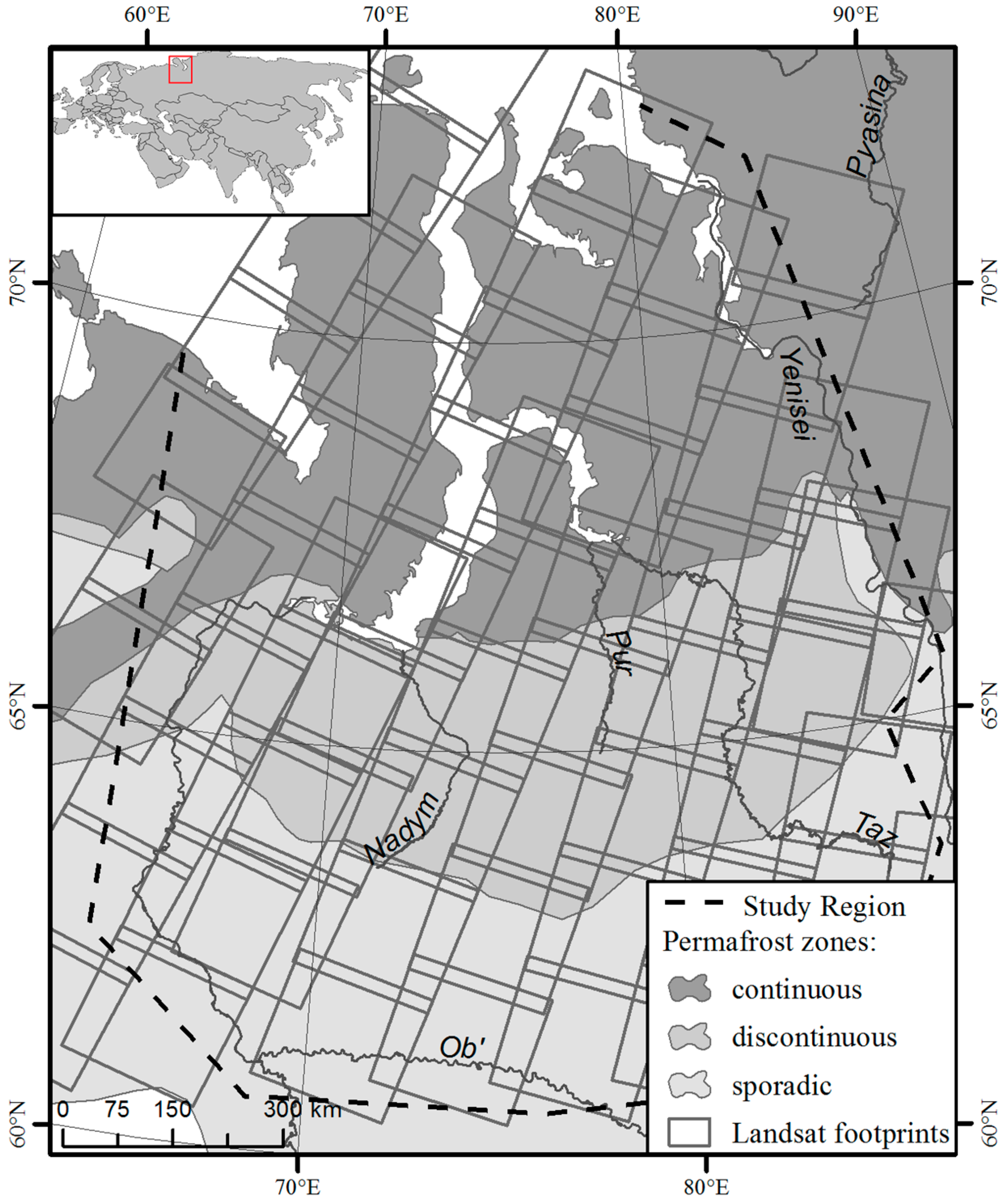
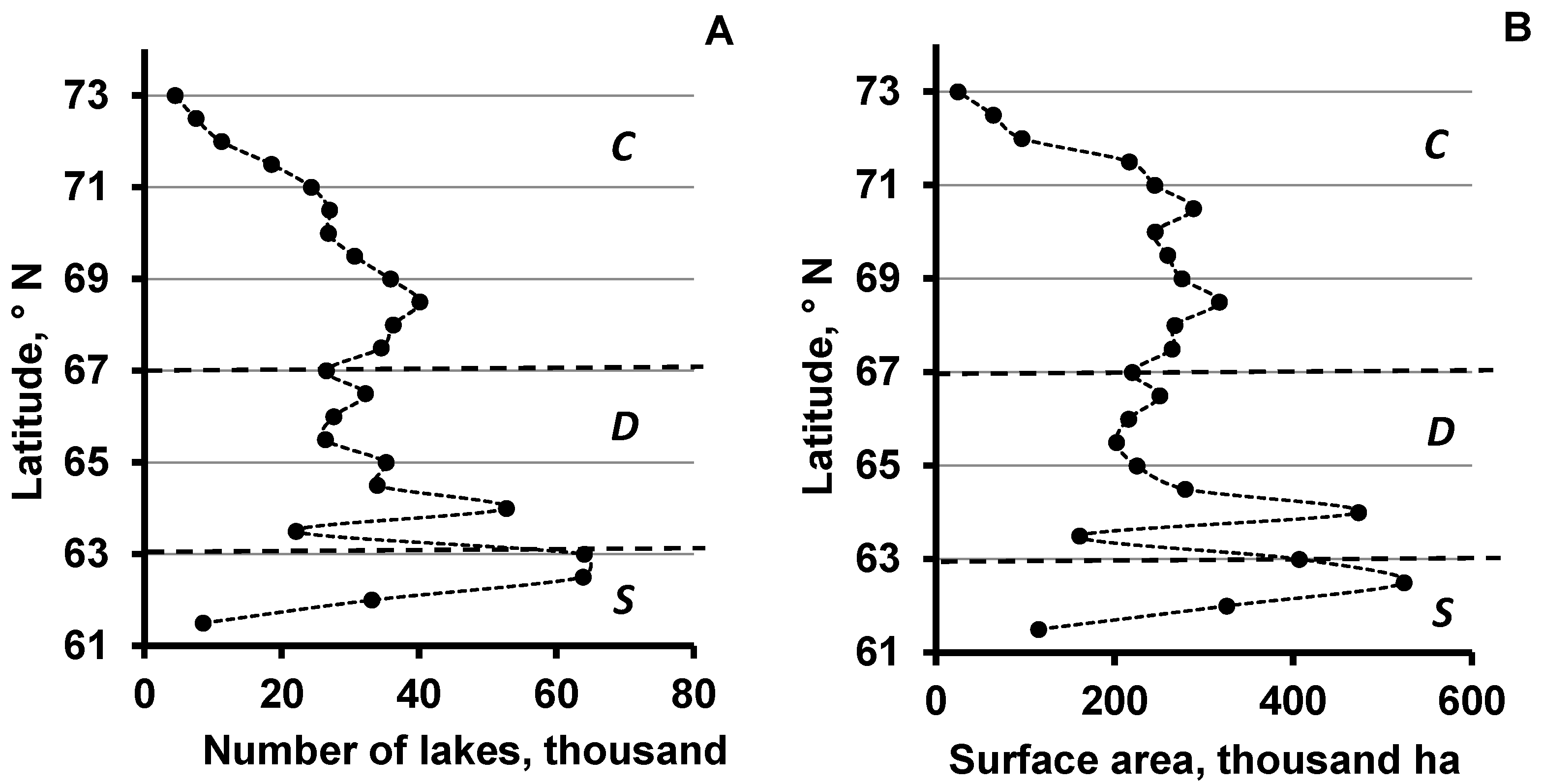

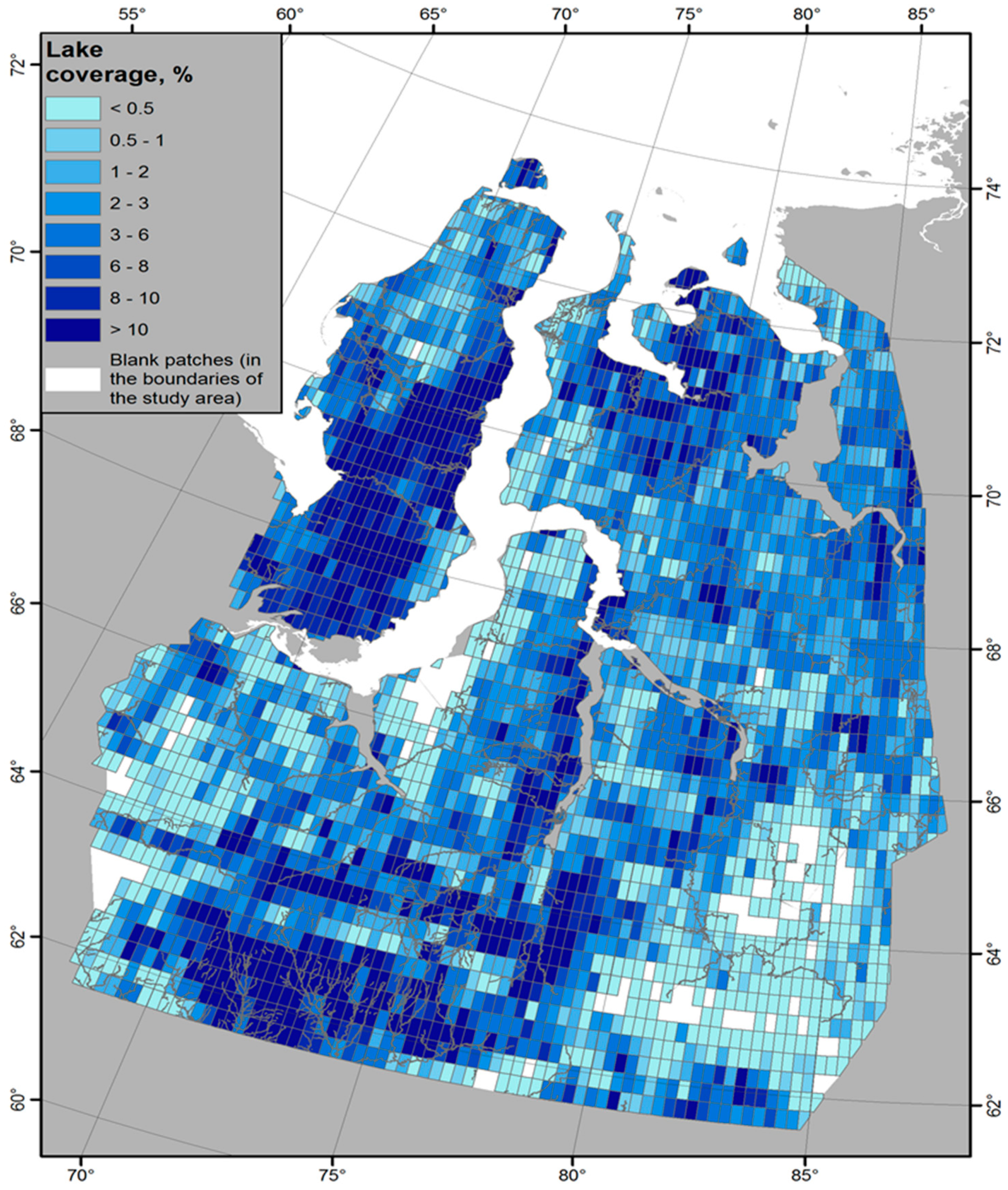
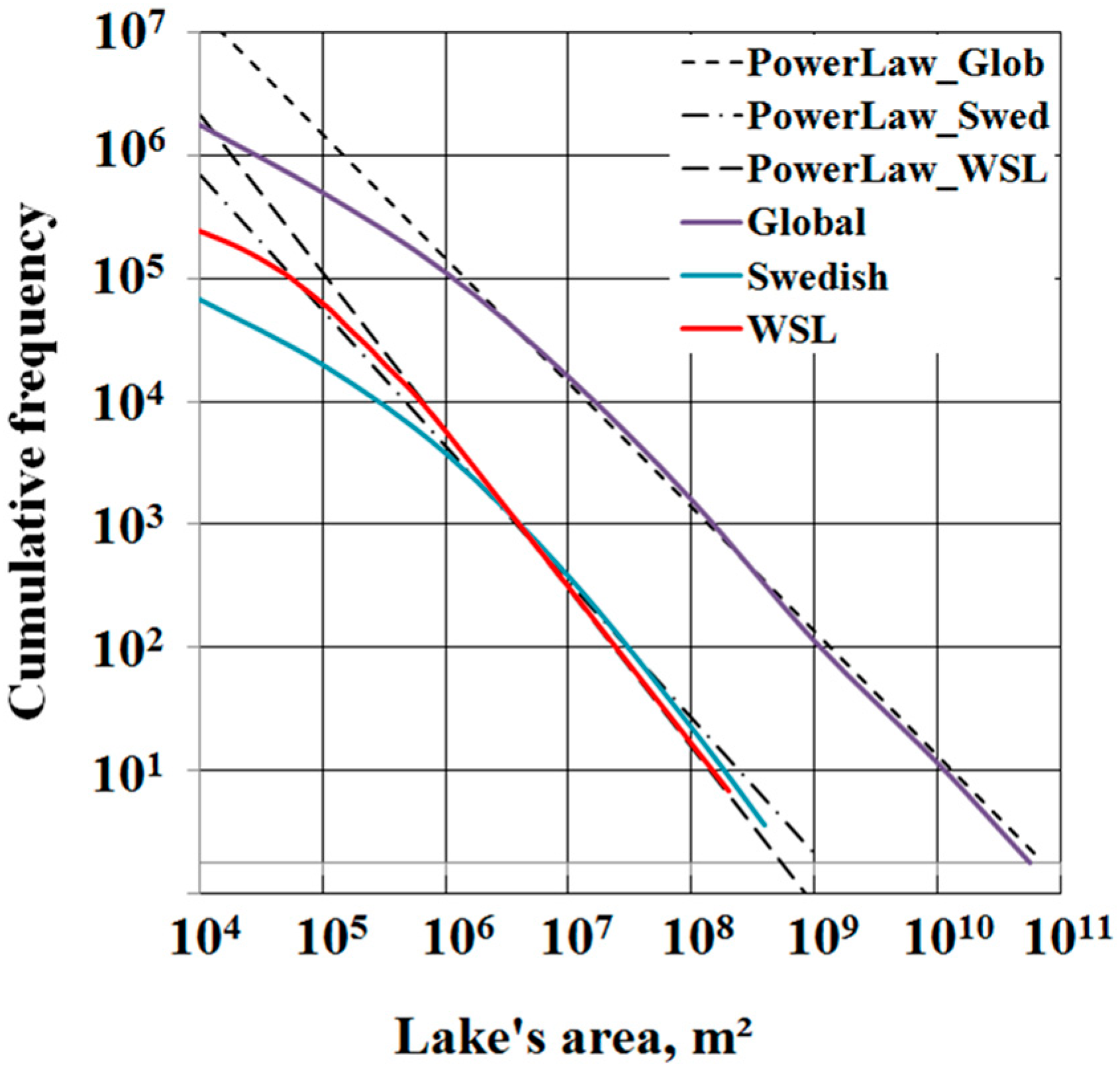
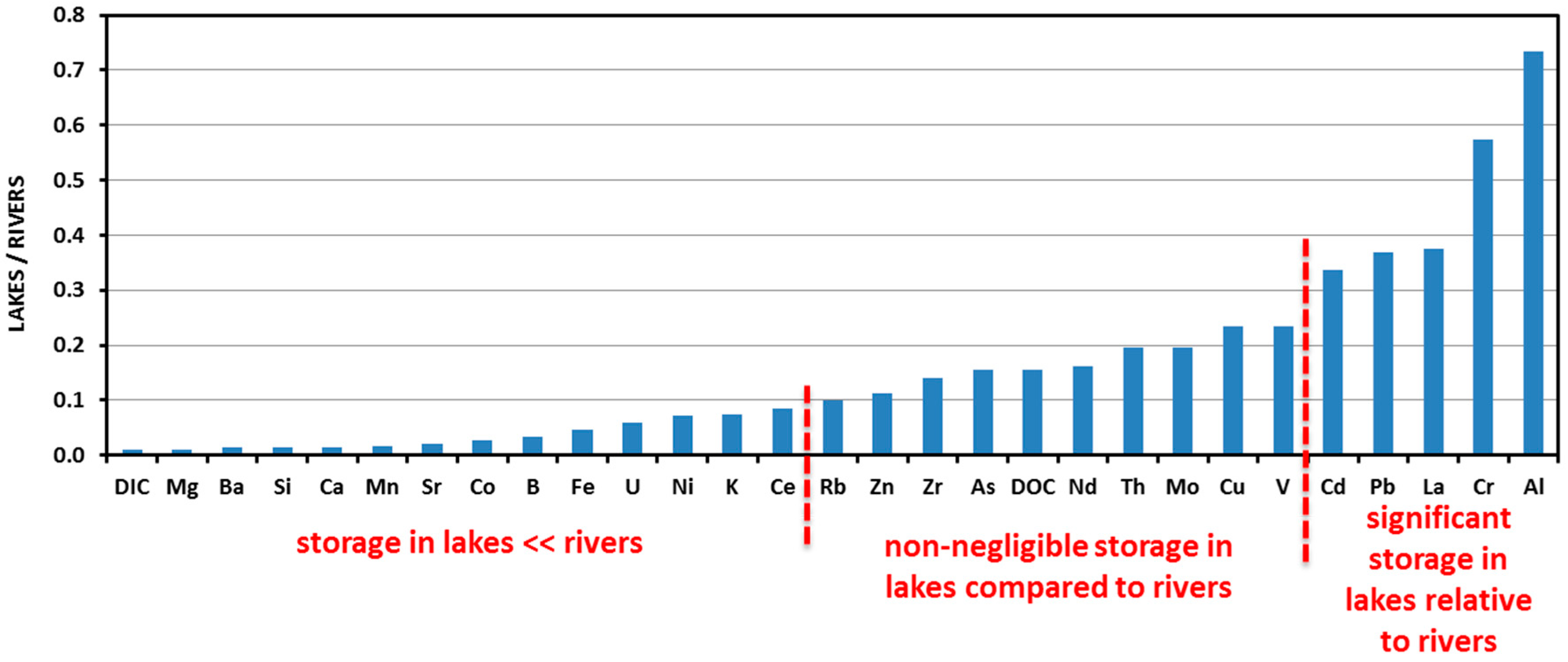
| Permafrost | Total Number of Lakes, Thousand | Total Area of Lakes, Million ha | Lake Coverage of the Area, % | Lake Density, Number of Lake per km2 |
|---|---|---|---|---|
| All territory | 727.7 | 5.97 | 5.69 | 0.69 |
| Continuous | 305.0 | 2.59 | 6.28 | 0.74 |
| Discontinuous | 207.7 | 1.65 | 5.41 | 0.68 |
| Sporadic | 215.0 | 1.75 | 5.26 | 0.65 |
| Size Range, ha | Number of Lakes | Their Surface Area | Water Stock | |||
|---|---|---|---|---|---|---|
| Lakes | % | ha | % | km3 | % | |
| 0.5–1 | 240,582 | 33.056 | 173,768 | 2.9 | 0.938 | 1.9 |
| 1–2 | 171,309 | 23.540 | 247,303 | 4.1 | 1.335 | 2.7 |
| 2–5 | 152,240 | 20.920 | 481,651 | 8.1 | 4.094 | 8.3 |
| 5–10 | 72,091 | 9.910 | 507,488 | 8.6 | 4.314 | 8.7 |
| 10–20 | 43,443 | 5.970 | 609,713 | 10.2 | 5.183 | 10.5 |
| 20–50 | 30,081 | 4.130 | 926,364 | 15.5 | 7.874 | 15.9 |
| 50–100 | 10,354 | 1.420 | 717,571 | 12.0 | 6.099 | 12.3 |
| 100–200 | 4636 | 0.640 | 638,175 | 10.7 | 5.425 | 11.0 |
| 200–500 | 2227 | 0.310 | 666,245 | 11.2 | 5.663 | 11.5 |
| 500–1000 | 511 | 0.070 | 352,499 | 5.9 | 2.996 | 6.1 |
| 1000–2000 | 169 | 0.020 | 233,803 | 3.9 | 1.987 | 4.0 |
| 2000–5000 | 57 | 0.010 | 162,680 | 2.7 | 1.384 | 2.8 |
| 5000–10,000 | 19 | 0.003 | 125,671 | 2.1 | 1.068 | 2.2 |
| 10,000–20,000 | 9 | 0.001 | 123,066 | 2.1 | 1.046 | 2.1 |
| Total: | 727,728 | 100.000 | 5965,997 | 100.0 | 49.40 | 100.0 |
| Zone | A | В |
|---|---|---|
| continuous | 15.96 × 109 | −2.224 |
| discontinuous | 6.82 × 109 | −2.154 |
| sporadic | 1.68 × 109 | −2.065 |
| Element | C, µg/L | Stock, Ton | Element | C, µg/L | Stock, Ton |
|---|---|---|---|---|---|
| DOC | 20,000 ± 10,000 | 500,000 ± 150,000 | Zn | 10 ± 5 | 500 ± 250 |
| DIC | 430 ± 100 | 22,200 ± 5000 | As | 0.63 ± 13 | 31 ± 6 |
| B | 3 ± 1 | 150 ± 50 | Rb | 0.3 ± 0.1 | 15 ± 5 |
| Mg | 190 ± 40 | 9400 ± 2000 | Sr | 6 ± 2 | 300 ± 100 |
| Al | 120 ± 20 | 6000 ± 1000 | Zr | 0.10 ± 0.03 | 4.9 ± 0.5 |
| Si | 300 ± 100 | 15,000 ± 5000 | Mo | 0.05 ± 0.02 | 2.5 ± 0.5 |
| K | 235 ± 60 | 12,000 ± 3000 | Ba | 3.0 ± 1.5 | 150 ± 75 |
| Ca | 700 ± 500 | 30,000 ± 20,000 | Cd | 0.02 ± 0.005 | 0.99 ± 0.25 |
| V | 0.6 ± 0.2 | 30 ± 10 | La | 0.20 ± 0.06 | 9.9 ± 3.0 |
| Cr | 1.0 ± 0.5 | 50 ± 25 | Ce | 0.10 ± 0.03 | 4.9 ± 0.5 |
| Mn | 20 ± 3 | 900 ± 150 | Nd | 0.10 ± 0.03 | 4.9 ± 0.5 |
| Fe | 200 ± 50 | 10,000 ± 4000 | Pb | 0.26 ± 0.05 | 12.8 ± 2.5 |
| Co | 0.10 ± 0.025 | 4.9 ± 1.2 | Th | 0.015 ± 0.005 | 0.74 ± 0.24 |
| Ni | 0.4 ± 0.2 | 20 ± 10 | |||
| Cu | 0.55 ± 0.15 | 27 ± 7 |
© 2017 by the authors. Licensee MDPI, Basel, Switzerland. This article is an open access article distributed under the terms and conditions of the Creative Commons Attribution (CC BY) license ( http://creativecommons.org/licenses/by/4.0/).
Share and Cite
Polishchuk, Y.M.; Bogdanov, A.N.; Polishchuk, V.Y.; Manasypov, R.M.; Shirokova, L.S.; Kirpotin, S.N.; Pokrovsky, O.S. Size Distribution, Surface Coverage, Water, Carbon, and Metal Storage of Thermokarst Lakes in the Permafrost Zone of the Western Siberia Lowland. Water 2017, 9, 228. https://doi.org/10.3390/w9030228
Polishchuk YM, Bogdanov AN, Polishchuk VY, Manasypov RM, Shirokova LS, Kirpotin SN, Pokrovsky OS. Size Distribution, Surface Coverage, Water, Carbon, and Metal Storage of Thermokarst Lakes in the Permafrost Zone of the Western Siberia Lowland. Water. 2017; 9(3):228. https://doi.org/10.3390/w9030228
Chicago/Turabian StylePolishchuk, Yury M., Alexander N. Bogdanov, Vladimir Yu. Polishchuk, Rinat M. Manasypov, Liudmila S. Shirokova, Sergey N. Kirpotin, and Oleg S. Pokrovsky. 2017. "Size Distribution, Surface Coverage, Water, Carbon, and Metal Storage of Thermokarst Lakes in the Permafrost Zone of the Western Siberia Lowland" Water 9, no. 3: 228. https://doi.org/10.3390/w9030228






